
This web page represents a distillation of the major ideas and information associated with the Biological Science (BIOL 1003) lecture course. References to page numbers, Figures, and Tables, are associate with reading assignments Asking about Life (3rd edition; 2005) by Tobin and Dusheck - reading assignments are noted in the Syllabus for BIOL 1003 for additional information. If you note any errors in the following document, I'd appreciate it if you would bring this to my attention. Email address: mhuss@astate.edu.
Examples of Tissues and Organs in Animals and Humans
- Tissue: similar cells performing an identical function (muscles; contraction; blood; oxygen transport by red blood cells).
- Organ: groups of different tissues performing a distinct function (eye: sight; brain: coordinates and processes nerve impulses)
Some major animal tissue types
- Muscle: movement, posture, beating of heart
- smooth - involuntary
- striated
- skeletal: voluntary
- cardiac: involuntary
- Epithelial - cells that cover organs and other structures
- Connective (bones, cartilage, blood, lymph)
- support
- transport of nutrients, energy, oxygen to tissue removal of carbon
dioxide and waste products from tissues
- plasma
- corpuscles
- red blood cells (erythrocytes) - movement of gases
- white blood cells (leukocytes) - removal of infectious agents through phagocytosis
- platelets (blood clotting)
- Nerve tissue - transmission and coordination of nerve impulses
- Refer to the following web site for additional information on tissue types at http://www.emc.maricopa.edu/faculty/farabee/BIOBK/BioBookAnimalTS.html
-
Refer to the following web site for additional information on organ systems, organs, and human body parts at http://www.innerbody.com/htm/body.html
- PowerPoint Presentation (PPT version) on Animal and Human Tissues
- Web Presentation (HTM version) on Animal and Human Tissues
An Example of an Organ System in Humans (Reproductive System)
Human Reproduction - refer to text and figures found in Chapter 44 in the textbook.
The nuclei in most human cells are diploid ==> 46 chromosomes: 22 pairs of homologous or autosomal chromosomes and 1 pair of sex chromosomes.
Gametogenesis - formation of haploid (23 chromosomes) gametes is the result of meiosis, cytokinesis, and cellular differentiation, which occurs in the gonads.
- Male gonads = testes
- Gametogenesis that gives rise to male gametes is called spermatogenesis
- Male gametes are called sperm
- Spermatogenesis starts in human males at the onset of puberty (age 12-13) and continues through the life of the adult
- Female gonads = ovaries
- Gametogenesis that gives rise to female gametes (one large ovum and three polar bodies) is called oogenesis
- Female gametes are called eggs or ova (sing. ovum) or oocytes (prior to release from the follicle).
- Oogenesis begins prior to birth, but cells destined potentially to become eggs, undergo meiotic arrest during Metaphase I and stay in stasis until the onset of puberty (age 12-13), and dispensed once every 28 days from puberty (age 12-13) through menopause (age 50)
Visit the following web site for additional information of Sexual Reproduction in Humans at http://www.emc.maricopa.edu/faculty/farabee/BIOBK/BioBookREPROD.html
Hormonal Control of Human Reproduction
A "releasing hormone" is produced by the hypothalamus (in the brain) causes the anterior pituitary gland to secrete luteinizing hormone (LH) and foollicle-stimulating hormone (FSH). These two hormones travel through the blood stream and migrate to the gonads.
- FSH=>stimulates gametogenesis and maturation of gametes
- LH=>stimulates accessory cells to produce sex steroids (all three
produced in males and female but in different concentrations
- (1) testosterone, (2) estrogen, and (3) progesterone
- Responsible for secondary sexual characteristics
- In females==>breast tissue proliferation, deposition of fat deposits
- In males==>voce quality, facial and pubic hair growth, muscle and bone development, and sex drive
Human Reproductive Structures and Function
Male Reproductive Organs and Function
Testes are found outside the abdominal cavity in a sac (scrotum).
Viable sperm are produced at a temperature lower than the human body
temperature (98.6 degrees F or 37 degrees C). Within a testis are the
seminiferous tubules (80% of testicular mass) and represents the
location of spermatogenesis. Sperm enter a coiled tubule called
the epididymis (found outside the testis). It takes about 10-12 days
for sperm to mature and gain the ability to swim. Sperm exit the
epididymis via the vas deferens; a duct that loops up behind the
bladder in the abdominal cavity and connects to the urethra.
The urethera passes through the penis. During intense sexual
arousal, blood fills blood vessels within the penis to generate an erection.
Sperm mixes with glandular secretions to produce the semen.
Semen is ejected by rhythmic contractions and leads to ejaculation.
Orgasm involves ejaculation, increases in blood pressure and heart rate,
skeletal muscles tense then relax, followed by mental relaxation and
sensations of pleasure. A refractory period during which time a second
orgasm is not possible follows.
Female Reproductive Organs and Function
The ovaries are the site of oogenesis (egg formation) and found within the abdominal body cavity. The uterus or womb is the location where the embryo implants and develops during pregnancy. Oviducts = Fallopian Tubes are necessary so the egg can travel from the ovary to the uterus. The vagina is opening of the body that leads to the uterus and serves as the entry point for sperm and exit point for the offspring at the end of pregnancy. Sexual union or copulation allows the semen containing sperm to enter the uterus and make its way to the egg, where fertilization is a possible outcome. Orgasm in the female leads to rhythmic contractions of the uterine muscle which may assist sperm in their journey to the egg.
The ovary contains follicles (sac-like structures each containing one oocyte). Female gametes mature in a monthly cycle (approx. 28 days) called the menstrual cycle. Menstruation = 3-7 day period of blood discharge from the uterus. This bloody discharge represents the removal of the endometrium. During the course of the menstrual cycle, hormone levels rise and fall. Low levels of estrogen inhibits the release of LH and FSH, while high levels of estrogen increase the release of LH and FSH in the pituitary gland. Ovulation occurs, the egg is released starting its journey to the Fallopian tubes. The used or spent follicles fill with cells and form the corpus luteum, causing progesterone levels to rise. The increased levels of progesterone prevents additional ovulation and helps the endometrium to remain thick.
Fertilization and Pregnancy
One sperm unites with an egg and leads to fertilization. The fertilized egg becomes the zygote. Due to the union of the contents of two haploid nuclei from the sperm and the egg, and the cytoplasm components of the egg, the zygote is diploid (23 pairs of chromosomes in the nucleus; maternal inheritance of the organelles/cytoplasm - e.g., mitochondria). The zygote undergoes cell division and a blastula (ball of cells) develops. As the cells differentiate, different tissues form in the embryo. Within 7 days, the embryo reaches the uterine cavity and implants. The placenta forms providing the embryo with oxygen and food, and generates more progesterone, which inhibits menstruation (which would result in a miscarriage). Gestation in humans takes 38-40 weeks; approx. 9 months after which a baby is born.
Potential consequences of sexual intercourse
production of children
emotional reinforcement of pair-bonding between consenting adults
potential spread of sexually-transmitted diseases (CHAPTER 44)
The following information is lacking in your
textbook, but information that is appropriate in the context of human sexual
biology and behavior.
(50% of newly diagnosed HIV cases are in individuals between the ages of 13-25, mostly as a result of heterosexual activity) |
|||||
Informative Links Regarding Sexually-Transmitted Diseases
- CDC Web Site: General Information on STDs at http://www.cdc.gov/nchstp/dstd/disease_info.htm
- CDC Web Site: Information on specific STDs at http://www.cdc.gov/node.do/id/0900f3ec80009a98
- CDC Web Site: STDs and Pregnancy at http://www.cdc.gov/std/STDFact-STDs&Pregnancy.htm
 Genetics (Biology of Heredity): A
Unifying Theme in Biology
Genetics (Biology of Heredity): A
Unifying Theme in Biology
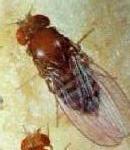
THE BASIS OF HEREDITY - HYPOTHESES FOR THE MECHANISM OF HEREDITY
1. Pangenesis - A hypothesis supported to some degree by Darwin to explain the hereditary process, involving the passage into the gametes of a gemmule from each part of the body, conveying information about the exact nature of that body part. Not supported by experimental data! Rejected view!
2. Blending Inheritance - the pre-Mendelian concept that progeny resulted from a blending of the traits of two sexually reproducing parents, with consequent loss of genetic variation on which natural selection could act. Not supported by experimental data. Blending Inheritance was also considered by Darwin and his contemporaries as a means for explaining how traits were inherited. Rejected view! Refer to Figure 9-3 and Figure 16-1 on pages 166 and 326 in the textbook.
3. Particulate theory of inheritance - the basis of mondern genetic theory, derived from Gregor Mendel's research, that characters are inherited as if they were particles, separating independently into gametes so that each variant of a character is maintained in a population in the absence of evolutionary change. Supported by experimental data!!! Accepted view! Refer to Figure 16-2 on page 326 in the textbook.
THE PATTERNS OF INHERITANCE
Gregor Mendel 1865 - founder of genetics (science dealing with heredity) - work was not appreciated until rediscovered 35 years later (Refer to Figure 9-19 on page 181).
 CLICK
HERE TO READ A TRANSLATION OF MENDEL'S NOW FAMOUS SCIENTIFIC PAPER
CLICK
HERE TO READ A TRANSLATION OF MENDEL'S NOW FAMOUS SCIENTIFIC PAPER
Peas are self-pollinating and self-fertile. Consequently plants were "true-breeding" because of repeated selfing or inbreeding (reduces genetic variation in a family line).
Gregor Mendel looked at seven different sets of characters or traits: Refer to Figure 9-20 on page 181 in the textbook.
- Seed color: yellow seeds vs. green seeds.
- Seed texture: smooth seeds vs. wrinkled seeds.
- Pod color: green pods vs. yellow pods.
- Stem length: long stems vs. short stems.
- Flower position: axial flowers vs. terminal flowers.
- Pod shape: inflated pods vs. constricted pods.
- Flower color: reddish-purple flowers vs. white flowers.
Self-pollination prevented by removing stamens. Crosses facilitated by transferring pollen to stigma and flowers covered with bags to prevent insect pollination. Refer to Figures 9-21 on page 182 in textbook.
MENDEL'S MONOHYBRID CROSS
P1 Purple flowering plant X White flowering plant
F1 All offspring produce purple flowers
F2 705 Purple flowering plants and 224 white flowering plants
How did Mendel explained or interpret the results? (Refer to Figure 9-22A on page 182 in the textbook)
UNIT CHARACTERS - He concluded that factors (genes) controlled a particular trait and that these came in pairs (alleles - different forms of the same gene)
DOMINANCE - Mendel recognized that alleles could be dominant or recessive.
P1
Purple flowers X
White flowers
PP
pp
F1
All offspring have purple flowers
Pp
F2 705 Purple flowering plants:224 White flowering plant OR approximately a 3:1 ratio
PRINCIPLE OR LAW OF SEGREGATION - Paired factors (genes) separate during formation of gametes.
Homozygous Dominant
Heterozygous
Homozygous Recessive
PP Pp
pp
Purple flowering plants
Purple flowering plants White
flowering plants
Chromosomal basis for explaining Mendel's results: different alleles for paired genes occur within a homologous pair of chromosomes
MENDEL'S DIHYBRID CROSS WITH PEA PLANTS
Purple flowers & Yellow seeds (PPYY) X White flowers & Green seeds (ppyy)
All Purple flowers and Yellow seeds (PpYy)
[PpYy X PpYy]
Possible gametes could carry: PY
or Py or pY
or py
Phenotypes that result include: 9:3:3:1 or 9 Purple/Yellow: 3 Purple/Green:3 White/Yellow: 1White/Green.
These phenotypes result from the following genotypes (blanks can represent a dominant or recessive allele, doesn't matter). 9 P__Y__: 3 P__yy: 3 ppY__: 1 ppyy
PRINCIPLE OR LAW OF INDEPENDENT ASSORTMENT - The dihybrid cross demonstrated that factors controlling two or more contrasting pairs of characteristics segregate independently and that gametes combine at random - refer to Figures 9-23 and 9-24 on page 184.
The law of independent assortment worked for Mendel, because each trait is
controlled as though genes occurred on different homologous pairs of
chromosomes, and the fact that homologues assort independently during meiosis.
BEYOND MENDELIAN GENETICS (What Mendel didn't know!)
Incomplete dominance - blending inheritance resulting from neither allele
masking the expression of the other allele (Snapdragon plants - Red flowered
plants R1R1 crossed with white flowered plant R2R2
yield progeny with pink flowers ===> R1R2). A cross
between two heterozygous plants for flower color yields a 1:2:1 genotypic and
phenotypic ratio! To confirm these findings perform a Punnett square and check
it out -
refer to Figure 9-18 on page 180 in the
textbook.
CODOMINANCE - both alleles are expressed (e.g., A and B antigens on red blood cells (RBCs) in humans for someone who has a blood type of AB; individuals heterozygous for two isozymes - alternate forms of the same enzyme - both are expressed).
ABO blood typing ===> three alleles ===> IA, IB or
i
(the null allele). Each allele causes the production of a membrane-bound
protein or antigen -
Refer to Table 14-1 on page 288 in
the textbook.
| Gentoypes IAIA or IAi yields TYPE A blood phenotype => body's immune system produces no anti-A antibodies. |
| Genotype IAIB yields TYPE AB blood phenotype = body's immune system produces no anti-A or anti-B antibodies = UNIVERSAL RECIPIENT (can receive blood from anybody) |
| Gentoypes IBIB or IBi yields TYPE B blood phenotype => body's immune system produces no anti-B antibodies. |
| Genotype ii yields TYPE O => No surface protein or antigen present - human body produces anti-A and anti-B antibodies - UNIVERSAL DONOR (can donate blood to anyone). |
Rhesus or Rh factor is a separate antigen found in the cell membrane. Its presence makes a person positive (+), its absence makes that person negative (-). Understanding the underlying basis of blood typing can be useful in: matching donors to recipients for blood transfusions, paternity suits, and criminal cases (where bodily fluid is left at the scene of the crime).
Example: A type B woman accuses a type O man of being the father of her child. Is it possible for the the accused man to be the father of the child, if he is type A? No! The child must receive at least one IA allele from one of the two parents. This allele could not have come from the mother (she does not possess this allele), so it must have come from the father. The accused man is type O, so his genotype is ii. He can not be the father of the child.
Blood typing can only eliminate individuals, but matches required further genetic testing (e.g., DNA fingerprinting - refer to Figure 14-3 on page 280 in the textbook) to confirm biological relationships.
Finally among humans, i is the most common allele, surpassing the incidence
of alleles,
IA and
IB. Therefore, just because an allele is recessive, does not
necessarily mean that it is less common compared to dominant alleles.
"Time flies like an arrow, fruit flies like a banana."
Sex linkage and Gene linkage - Refer to Thomas Hunt Morgan's experiments on fruit flies (Drosophila melanogaster): Refer to Figure 9-25, 9-26, 9-27, and 9-28 on pages 186-188. Also see: http://uk.encarta.msn.com/media_121636626/Fruit_Fly_Chromosomes.html. Examples of sex-linked phenotypes in humans resulting from the expression of a specific allele occupying a locus on a sex chromosome include: hemophilia (a blood-clotting disorder) and color-blindness with the gene located on the X chromosome; hairy ears in males with the gene located on the Y chromosome.
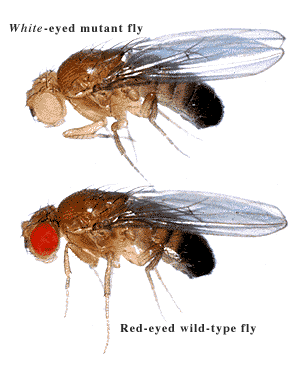
Tortoise-shell cats and Calico cats (calico cats are the same as a tortoise shell cat but also possess white patches of fur) are usually female due to the linkage of either the Orange-colored or Black-colored allele for fur color to an X chromosome. In the heterozygous condition both are expressed in different regions of the cat's body. Male cats that possess one dose of the X chromosome will either exibit black or orange, but not both at the same time.
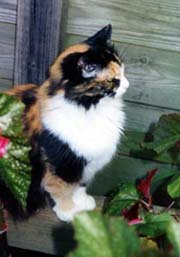
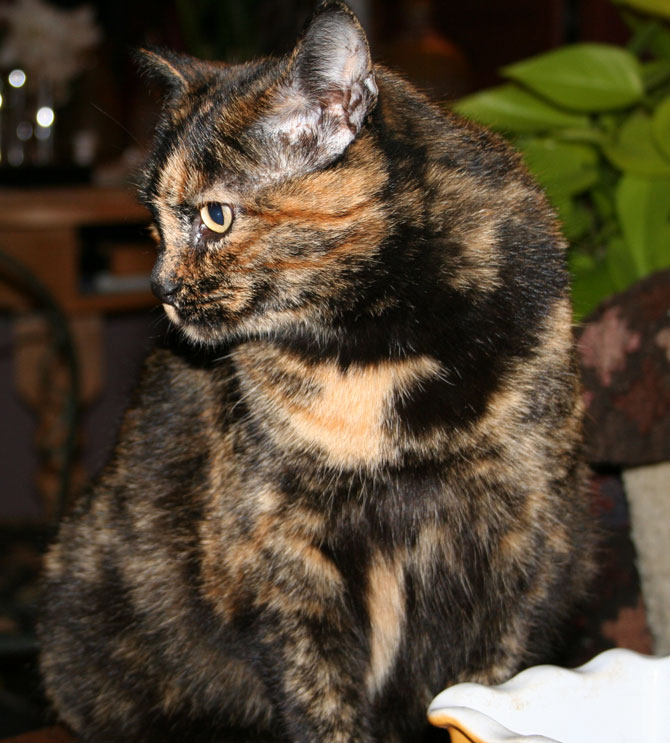
Calico cat Tortoise-shell cat
Refer to Walter Sutton's Six Rules of Inheritance in Table 9-1 on page 185.
MENDELIAN GENETIC PRACTICE PROBLEMS - GO TO TOP OF PAGE AND VISIT THE LINK LISTED TO PRACTICE THE PROBLEMS GIVEN IN THE MENDELIAN GENETICS - PROBLEM SET.
THE ANSWER KEY TO GENETIC PROBLEMS CAN BE FOUND AT http://www.clt.astate.edu/mhuss/genetics_solutions.htm.
EPISTASIS - interactions of one gene with other genes can mask the effect of other genes. Modifier genes
Albinism - complete absence of melanin (a pigment located in hair, fur, skin, feathers, etc.).
Series of biochemical reactions lead to formation of melanin. If the enzyme tyrosinase is not produced due to a mutation in a gene then no melanin can form. The result is an albino animal.
Chemical precursors ====> =====> ====> tyrosinase ======> =====> melanin
Albinism has been observed in white rabbits, laboratory mice, humans, squirrels (such squirrels occur in Jonesboro - personal observation), deer (female deer or doe sighted by student near northeast Arkansas in Fall 2003), moose, ravens, kangaroos, etc.
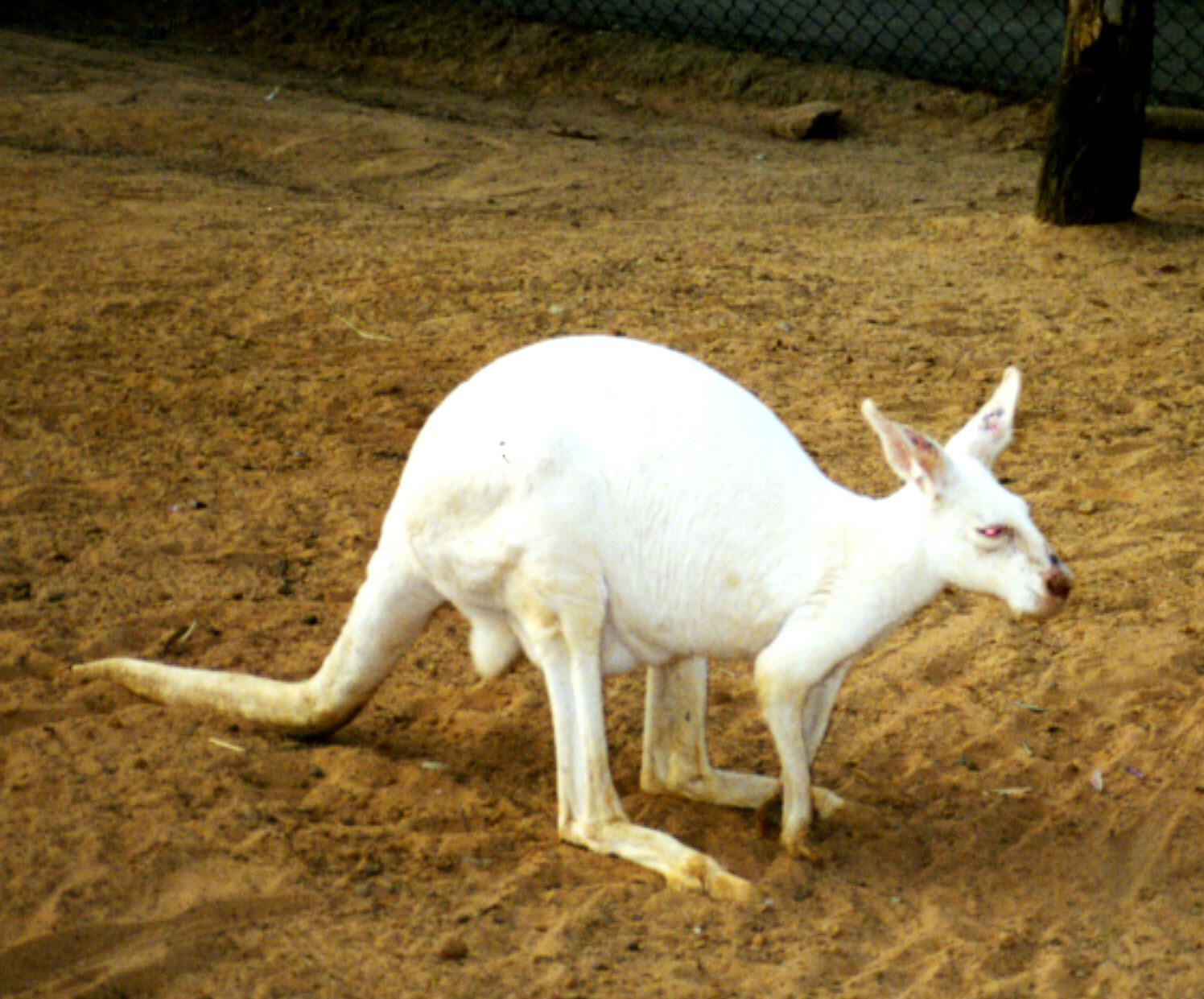
An albino kangaroo from Australia - photograph by B. Buerkle (2000).
PLEIOTROPY - gene expression where one gene exerts effect on seemingly unrelated aspects of an individual's phenotype. Example: Sickle cell anemia and cystic fibrosis - refer to Figures 10-13, 10-14, 14-9 on pages 204 and 286 in the textbook.
sickle-cell anemia ===> disease is result of a single gene that has mutated (hemoglobin).
HbA (normal hemoglobin vs. HbS - sickle cell type hemoglobin (due to one amino acid substitution) ===> Both types of protein can be discriminated from one another by how fast they travel through a gel subject to an electrical field (electrophoresis).
POLYGENIC EXPRESSION OF TRAITS: Many phenotypes are the result of many genes interacting with one another - refer to Figure 14-10 on page 287 in the textbook.
EFFECTS OF THE ENVIRONMENT ON GENETIC EXPRESSION
Himalayan rabbits and siamese cats (fur on extremities are black, rest of body fur is white to gray in color). Melanin is the pigment deposited in fur that creates dark fur. Melanin production requires a temperature sensitive form of tyrosinase.
ct = recessive allele for gene producing temperature-sensitve form of tyrosinase
ctct ===> warm ===> no pigment
ctct ===> cold ===> pigment present
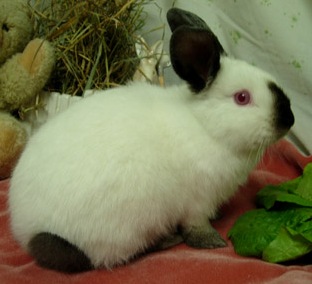
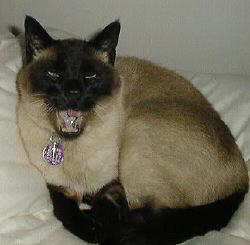
Himalayan rabbit Siamese Cat
Interaction of genes with genes and the genotype with the environment that
leads to the phenotype (observable traits). For example, identical twins share
the same genotype but are seldom identical in all respects due to the influence
of the environment on their growth and developmen (refer to Figure
9-4 on page 169 in the textbook). In another example, people
on average, are taller today than they were one hundred years ago due to better
nutrition, not due to better genes!
GENETICS AND DARWINIAN THEORY
The field of genetics and Darwinian theory of Evolution seemed to be at odds with one another during the first part of the 20th century. The observation of discontinuous genetic variation observed in the laboratory (refer to Figure 16-3 on page 330 in the textbook) seemed contrary to the continuous variation observed in field studies (refer to Figure 16-5 on page 331 in the textbook.; and the following Figure of voluntary class data from Fall semester 2000).
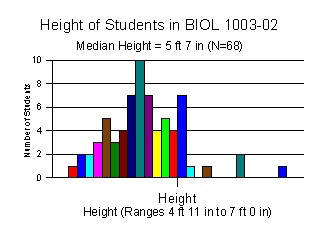
Over time, biologists realized that traits observed in organisms in nature were under the control of paired alleles, but that the degree to which the phenotype was manifested also depended on the interaction of genes within the organism with other genes (polygenic traits - refer to Figure 16-4 on page 330 in the textbook) and the interaction of the genotype with the environment.
During the 1920's and 30's the emergence of NeoDarwinism or the Modern Synthesis arose, which attempted to meld Darwinian evolutionary theory with Mendelian Genetics. The infusion of genetics with evolutionary study and helped generate the fields of population genetics and systematics, among others. Proponents of the Modern Synthesis included Ernst Mayr, Theodosius Dobzhansky, and Sewall Wright. Such terms as gene pool, gene flow, allele frequencies arose out of this work.
An early problem tackled by population geneticists was the question of
whether dominant alleles were more likely to persist in natural populations than
recessive alleles? Godfrey H. Hardy and Wilhelm Weinberg demonstrated that
this is not necessarily so: dominance (ability to mask the expression of a
recessive allele) is not equated with dominant alleles being inherently better
than recessive alleles.
WHAT IS A GENE?
HISTORICAL PERSPECTIVE: After biologists became convinced in the existence of genes during the early part of this century, it was far from clear on how such genes (and alleles - alternate forms of a gene) were responsible for conveying information from one cell generation to the next or how this information was actualized into the phenotype of an individual. Through the work of a number of individuals (Archibald Garrod - 1902; Beadle and Tatum - 1930's; Linus Pauling - 1949; Fredrick Griffth - 1928; Oswald Avery - 1930's, Alfred Hershey and Martha Chase - 1952; Erwin Chargaff - 1940's; and many other researchers), three major conclusions were made:
- The fundamental processes of life are chemical and physical in nature and can be explained in large part through an understanding of chemistry and physics.
- Many genes, when expressed yield protein (often in the form of some type of enzyme). This became known as the ONE GENE ===> ONE PROTEIN HYPOTHESIS.
- Nucleic acid (deoxyribonucleic acid - DNA), not protein, forms the molecular basis for genes that control cellular processes and it is this molecule that harbors the blue print of life that is passed on from one generation to the next.
Genetic Engineering and Bioengineering
-
Click here for PowerPoint Presentation on Genetic Engineering
-
Click here for Web-based version of Presentation on Genetic Engineering
-
Click here for PDF version of Presentation on Genetic Engineering
- Transformation - introduction of a new gene into a bacterium, fungus, plant or animal by some mechanism. (i.e., bombardment, electroporation, virus- or bacteria-mediated gene transfer) - refer to Figures 13-5, 13-12, and 13-13 and 13-14 on pages 263, 271, 272, and 274 in the textbook.
- Addition of new genes (to express a new gene product).
- Suppression of a gene or a gene product.
Genetic engineering can produce organisms that are:
- able to synthesize oils, starches, hormones (e.g., bacteria that produce human insulin for use by diabetics) and plastics
- edible vaccines from vegetables and milk
- able to synthesize enzymes for food processing and other uses
- more nutritious foods (e.g., plants with a higher protein content, and wider profile of essential amino acids - methionine-rich beans or lysine-rich corn; golden rice to help enrich the diets of those not able to eat foods rich in beta-carotene or Vitamin A to prevent blindness caused by a nutritional deficiency)
- plants able to fix their own nitrogen for growth
- freeze resistant plants
- pest resistant plants
- herbicide resistant plants
- disease resistance in animals and plants
- gene therapy to help cure certain diseases linked to the under or over abundance of a protein product by a genetic disorder - refer to Figure 14-14 on page 293 in the textbook
Potential problems
- Allergies to transformed plant and animal products.
- Accidental movement of novel genes into wild relatives from domesticated plants and animals.
- Consumer resistance to using genetically-modified products, especially food and drugs.
- Ethical and moral considerations. (e.g., exploitation of genetic resources for personal gain).
EXAMPLES OF GENETIC ENGINEERING: The zebra fish, shown below on the left, are the "normal" or "wild-type" form of the fish without the introduction of a protein that causes these fish to glow or fluoresce under a black light. The fish, shown below on the right, have been "transformed" by the introduction of a novel gene from a sea anemone or coral that causes these fish to "glow" a reddish color under black light.
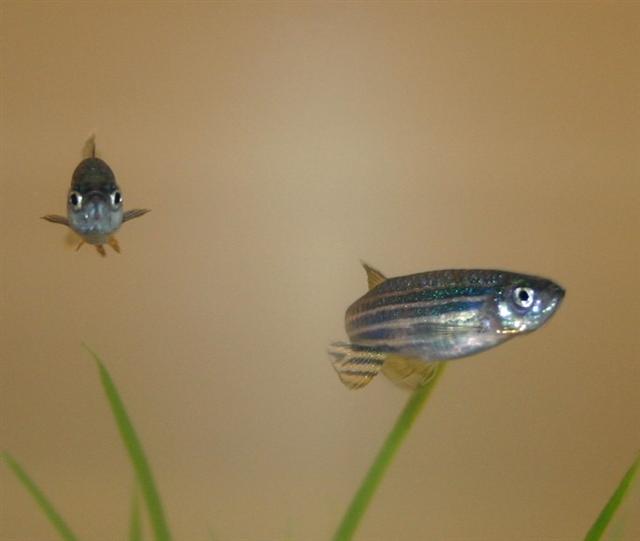

Normal zebra fish Genetically-engineered Glofish
For more infomation on GloFish visit:
- http://www.glofish.com/
- http://www.isb.vt.edu/articles/jun0405.htm
- http://www.msnbc.msn.com/id/3759755/
HUMAN IMPACT ON THE ENVIRONMENT - refer to text and figures in Chapter 28 found in the textbook. Discussion in lecture as time allows.
-
Human population growth
-
deforestation
-
air pollution (CFC's, greenhouse gases, ozone layer loss)
-
water pollution (industrial waste, petroleum, agrochemical runoff)
-
solid waste and land-fills
-
urban sprawl and land use
-
greenhouse effect and global warming
-
conventional and nuclear war
-
decline in biodiversity and collapsing of ecosystems/biomes
SEE BELOW FOR ASSIGNMENT FOR DISCUSSION ON MONDAY 24 April 2006
BIOL 1003 - Biological Sciences: Topic of Discussion for 24 April 2006
THE IMPACT OF HUMANS ON THE ENVIRONMENT & OTHER LIFE FORMS
Visit the library and/or find information on the internet via a search engine with a web browser for news stories or journal articles and other information related to one or more of the following topics:
· Human population growth
· Deforestation
· Air pollution (CFC's, greenhouse gases, ozone layer loss)
· Water pollution (industrial waste, petroleum, agrochemical runoff)
· Solid waste and land-fills
· Urban sprawl and land use
· Greenhouse effect and global warming
· Conventional and nuclear war
· Decline in biodiversity and collapsing of ecosystems/biomes
Find at least three articles related to the topics listed above. Read over and review these and be prepared to discuss your findings during class on Friday, December 2, 2005. Please work independently to help maximize the amount of information can be gathered collectively by participants in this class. As evidence that you have collected this information yourself, photocopy the newspaper, news magazine, or journal article, or print the first page of each internet-based article. It is not necessary for the purposes of this exercise that you photocopy or print all of the pages of the news article or informational account as long as the citation or web address is printed or written on the first page that you bring to class on Wednesday. Collate these and staple them together. Put you name at the top of the first page so that I can assign a grade to you for participation for this part of the exercise.
In preparing for this discussion in class on Monday, April 24th, keep in mind the following questions:
-
Does the information in the article pertain to you in some real or meaningful way?
-
Is the human impact on other humans, other species, and the environment, negative or positive?
-
What are the short-term consequences of the information provided by the article?
-
What are the long-term consequences of the information provided by the article?
-
If necessary, what are some tangible ways to become involved in creating change in how humans interact with other life forms and the environment?
-
Other thoughts?
This page was assembled by Martin J. Huss, who can be reached at
mhuss@astate.edu.
Last revised on: April 17, 2006.